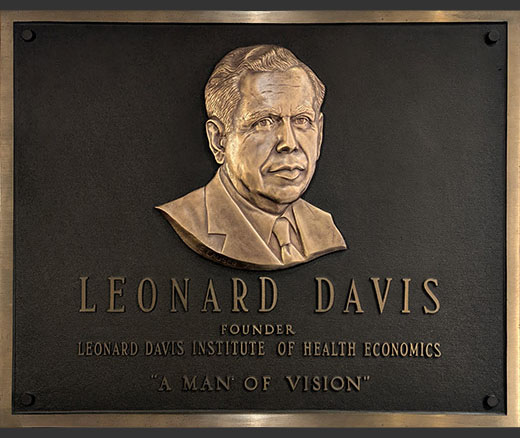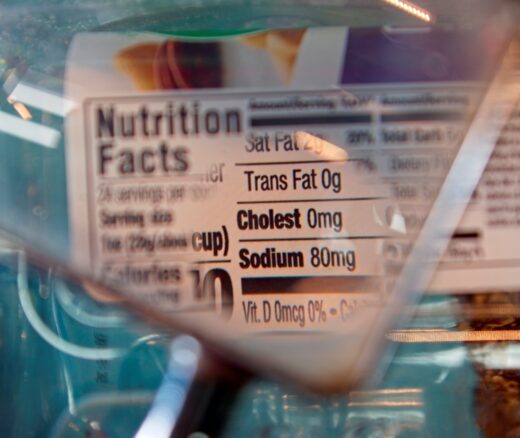
Understanding the Evidence: SNAP and Health
Six Studies That Highlight How Losing SNAP Can Raise Food Insecurity and Affect Health
Blog Post

Hundreds of medications sold on U.S. store shelves today once were available only by prescription. Examples of such prescription-to-over-the-counter (Rx-to-OTC) switches include Advil, a nonsteroidal anti-inflammatory drug; Nasonex, a steroid nasal spray for allergies; Prilosec, a stomach-acid-reducer; and, just now reaching drugstores, Narcan, a nasal spray version of naloxone, which reverses the effects of opioid overdoses. Soon Opill, the first OTC oral contraceptive, also will be available without a prescription. Rx-to-OTC switches “are intended to make a medication more accessible to patients. Getting a prescription from a doctor can be burdensome,” said LDI Senior Fellow Sean Hennessy, Professor, Biostatistics, Epidemiology, and Informatics at Perelman School of Medicine.
Some Rx-to-OTC switches have been great successes. For instance, during the first year after nicotine replacement therapies went from prescription-only to OTC, their sales jumped 150% to 200%, according to the Consumer Healthcare Products Association (CHPA), a trade group. The conversion may be less predictable for two medications—the overdose-reverser Narcan and the contraceptive Opill.
Opill and Narcan are major tools in efforts to stem two U.S. public health crises—the worst maternal mortality in the developed world, and the opioid epidemic, which killed almost 83,000 people last year according to the Centers for Disease Control and Prevention (CDC). “The idea is to get medications that we know save lives into people’s hands. Effective contraception prevents pregnancy when it’s not safe for people to become pregnant. Naloxone halves overdoses,” noted LDI Senior Fellow Alice Abernathy, Assistant Professor, Obstetrics and Gynecology at Perelman. However, she added, “Cost, stocking issues, and placement behind pharmacists’ counters may reduce their accessibility.”
LDI experts weigh in on the changes that may look more impactful than they end up being—unless policymakers intervene.
Opill and Narcan are both medications that need to be either on hand or quickly available to work. According to the CDC, two of five pregnancies in the United States are unintended—a figure that could be reduced with easily available contraception. Reproductive rights groups such as the Free The Pill Coalition spent more than 20 years advocating for an OTC oral contraceptive. In July, Opill became the first oral contraceptive to be approved for OTC sales, and it is set to hit the shelves in 2024. Opill contains only progestin and should be taken at the same time each day to be most effective.
“There’s a narrow time window, narrower than with combined estrogen and progestin contraceptives, in which a person can take Opill for it to be effective,” said Abernathy. “Patients need to be able to walk into a pharmacy and purchase Opill right away, for example, if they’re traveling and left their pills at home.” Similarly, Plan B One-Step, approved as a nonprescription drug in 2006, has time constraints. It should be swallowed within 72 hours after unprotected sex.
And naloxone, in all its formulations, needs to be administered as soon as possible to a person who has overdosed. If administered soon enough, the drug blocks the impact of opioids on the brain and restores respiration in two to three minutes. The drug is widely distributed by harm-reduction organizations, both in its prescription-only injectable formulation and as a nasal spray. The nasal-spray version of naloxone that recently became available OTC “is much less intimidating for lay people to use than intramuscular naloxone. You just put it in someone’s nose and spray, versus having to give an injection,” said LDI Senior Fellow, Shoshana Aronowitz, Assistant Professor, Family and Community Health, Penn Nursing. Because of the potential benefits of OTC naloxone, the Washington Post referred to the switch as “a milestone in the fight against the nation’s overdose crisis.”
Making drugs available without a prescription is only part of improving access to them. Another piece is how pharmacies offer products that some people might feel are controversial. “Emergency contraception like Plan B is often not universally stocked, which means that a pharmacy has to order it, and the patient has to come back, sometimes in 24 hours, which cuts into the window in which the medication is effective,” Abernathy said.
Availability differs throughout the United States. For instance, 87% of pharmacies in Colorado stocked Plan B and its generic equivalents, according to a 2017 report, but 42% kept it behind the counter rather than on store shelves. “For some people, going up to the pharmacy counter and requesting medication is an intimidating process,” said Abernathy.
In addition, even though the drugs have been available to all ages OTC since 2014, purchasing Plan B and its generics can be difficult for adolescents. When male and female data collectors, posing as 16-year-olds who wanted to prevent a pregnancy after recent unprotected sex, phoned pharmacies in Arizona, California, Utah and New Mexico, they frequently met resistance even where emergency contraception (EC) was available, according to a 2018 study. Pharmacy personnel often hindered youths’ access to EC by mentioning incorrect point-of-sale restrictions, keeping EC in restrictive store locations, or asking personal questions. Overall, the study found that EC was completely accessible to an adolescent caller in only 28% of the pharmacies contacted. Why the extra barriers? “It’s impossible to overlook the way that women’s reproductive autonomy is stigmatized, especially among certain populations like adolescents,” Abernathy said. “But as a physician who prescribes Plan B regularly, I see no reason it should be behind the counter.” Abernathy is concerned that some pharmacies will also keep Opill off the store’s shelves.
Because Narcan has only recently become an OTC medication, it is difficult to know how easy it is to obtain at pharmacies. But one indication comes from studies that looked at the accessibility of naloxone after states improved access laws. All 50 states and the District of Columbia have naloxone access laws, typically standing orders, that authorize pharmacists to prescribe nasal spray or injected forms of the medication to anyone, such as the parent of an opioid user. “Standing orders don’t make the drug available without a prescription, they just make the prescription trivial because a prescription is issued to basically everyone who wants one,” Hennessy explained.
However, several studies show that pharmacies do not consistently stock naloxone. For example, 55% did not have it on hand in a Pennsylvania study and 69% did not have it in stock in a Georgia report. Even when the drug is stocked, pharmacies may resist making it readily available. In a mystery shopper study in Mississippi, 41% of pharmacies were unwilling to dispense naloxone under state standing orders.
What do these findings suggest about Narcan’s availability? “Pharmacies that carried naloxone previously will continue (and may choose to put it on the regular shelves), and pharmacies that didn’t want to carry it before might still not carry it,” Aronowitz said. “Perhaps some pharmacies that didn’t carry it before will choose to now, but I think the stigma that drove the reticence to carry it before still applies.”
Another concern is that pharmacists may keep OTC Narcan off the shelves and behind the pharmacist’s counter. Media reports indicate that some pharmacies in Philadelphia are doing exactly that, even though local law requires them to stock it. “If Narcan is technically OTC but you still have to go to the pharmacy counter to buy it, there’s no benefit at all,” said Aronowitz, who places partial blame on stigma against people with substance use disorders. “We see less of this now, but you can still find instances of people saying that offering naloxone is condoning drug use or incentivizing risk-taking because it is available.”
One flaw in the Rx-to-OTC switch is that prescription medications that are currently paid for by private insurance often are not covered as OTC drugs. Also, depending on the state, Medicaid covers some OTC drugs, like contraceptives and Narcan, only with a prescription (which could entail a trip to the doctor’s office and/or pharmacist’s counter). And federal regulations prevent traditional Medicare from funding nonprescription items (although some Medicare Advantage plans might include those expenses). Opill does not have a price yet, but since it is a daily pill, “the cost of multiple months’ supply could add up quickly,” Abernathy said.
Similarly, Narcan, which retails for $44.95 and sometimes higher, is out of reach for people who struggle to pay their bills. “Clearly price is a big barrier to a lot of people,” Aronowitz said.
The high price reduces how many doses harm-reduction organizations can give out. One positive development has been the approval of a second, lower-priced OTC naloxone nasal spray. Called RiVive, the OTC-only spray contains 3 mg of naloxone, slightly less than Narcan’s 4 mg. Created by the nonprofit Harm Reduction Therapeutics, the drug will sell next year for around $30 and mainly be distributed to community organizations.
More competition may be on the way. The FDA played a significant role in the development of an OTC naloxone nasal spray—it encouraged pharmaceutical companies to create one and paid for some of the testing—and it continues to call for new OTC nasal sprays that could lower costs. “It seems like a no-brainer that the government should be doing whatever it can to make naloxone more affordable,” Aronowitz said.
With the stocking, pricing and insurance concerns, Aronowitz tempers her enthusiasm about Narcan’s Rx-to-OTC switch: “My main takeaway is that this is not going to come close to fixing the overdose crisis. It’s a small step in the right direction, but it’s not something that will have a meaningful difference for a lot of people.” Abernathy comes to a similar conclusion on Opill: “FDA approval of OTC status is a good first step, but making Opill available to everyone who needs it may require more work.”
“Some states currently mandate insurance coverage for contraceptives, so I think we have good models that say this is feasible. Federal intervention is necessary because there’s a breakdown in states’ willingness to create this regulation,” Abernathy said. And, in fact, the federal government is currently considering a requirement that public and private insurers cover certain OTC items, such as OTC oral contraceptives, without a prescription. At the same time, the Centers for Medicare and Medicaid Services is encouraging states to cover Narcan without a prescription.
Philadelphia has a city law that requires pharmacies to stock naloxone, although the level of enforcement is unclear. “I wonder if similar mandates could work elsewhere,” Aronowitz said. Contrast Philadelphia with New York, which has no mandate. Fewer than half of the over 2,600 pharmacies in New York City offer naloxone.
In any case, drugstores are not where most people access overdose-reversal medication. “A lot of distribution has been at community-based harm-reduction organizations, usually for free. Harm-reduction programs serve a different population, one at higher risk of overdoses, than people who would go to a pharmacy to pick up Narcan,” Aronowitz said, noting that “these community groups are just so underfunded. OTC naloxone at pharmacies should not preclude ramping up support for them.”
| LDI Fellows Suggest These Changes Could Make A Difference: The Federal government should mandate insurance coverage for all over-the-counter covered by both publicly funded and commercial insurance. Local and state governments should mandate that all pharmacies sell naloxone. Funders should increase support for harm-reduction organizations. |


Six Studies That Highlight How Losing SNAP Can Raise Food Insecurity and Affect Health

Includes $1 Million in Donations to Meet a Matching Challenge

Government Regulatory Power Wanes as Power Accrues to Courts and Corporations

Temporary Shutdown Losses are Only the Beginning: New Rules Under the One Big Beautiful Bill Act will Shrink SNAP Benefits, and Worsen Food Insecurity for Millions Across the U.S.
Research Brief: Shorter Stays in Skilled Nursing Facilities and Less Home Health Didn’t Lead to Worse Outcomes, Pointing to Opportunities for Traditional Medicare

A New Call to Action Urges Three Ways State and Local Leaders Can Act To Ban Additives, Improve Food Labels, and Restrict Marketing to Children